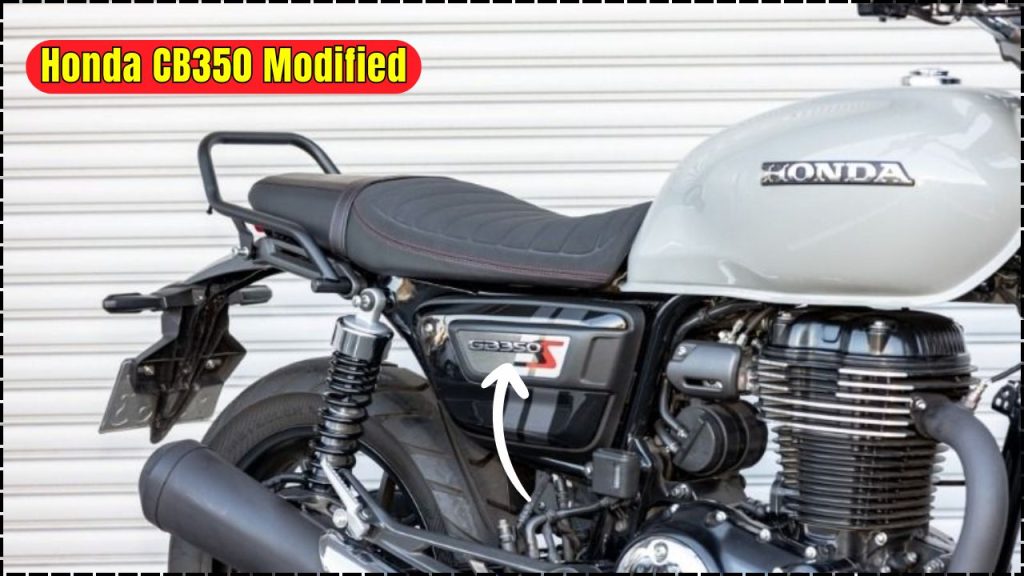
The motorcycle modification scene has always been about pushing boundaries while respecting the original design philosophy. Japanese aftermarket specialist Kijima has demonstrated this principle beautifully with their latest creation – a Honda CB350 transformed into a capable touring machine that maintains the bike’s classic charm while adding serious long-distance credentials.
The Foundation: Honda’s Retro Revival
Honda’s CB350, marketed as the GB350 C in Japan, represents the company’s strategic response to Royal Enfield’s dominance in the retro-classic segment. This motorcycle captures the essence of vintage motorcycling while incorporating modern reliability and efficiency. The single-cylinder engine produces a modest but adequate 20.7 bhp and 29.4 Nm of torque, making it an ideal canvas for modification projects that prioritize character over outright performance.
The CB350’s design language speaks to motorcycling purists who appreciate clean lines, minimalist aesthetics, and purposeful engineering. It’s this foundation that makes Kijima’s transformation so compelling – rather than overwhelming the original design, their modifications enhance and complement Honda’s vision.
Kijima’s Vision: Functional Touring Excellence
At the Tokyo Motorcycle Show 2025, Kijima unveiled their comprehensive touring package for the Honda CB350, showcasing how thoughtful modifications can transform a standard motorcycle into a long-distance companion. The Japanese company’s approach demonstrates years of experience in understanding rider needs and translating them into practical solutions.
The modification philosophy centers on three core principles: enhanced rider comfort, increased cargo capacity, and improved weather protection. Each component in the touring kit serves a specific purpose while maintaining visual harmony with the motorcycle’s original aesthetic.
Wind Protection: The First Line of Defense
Long-distance touring demands effective wind management, and Kijima has addressed this comprehensively. The centerpiece of their wind protection strategy is a tall, clear windscreen mounted above the headlight unit. This screen deflects airflow over the rider’s torso, reducing fatigue during extended highway stretches.
Complementing the main windscreen are custom leg shields that provide lower body protection. These shields are color-matched to the motorcycle, ensuring they appear as factory equipment rather than aftermarket additions. The attention to detail in color matching demonstrates Kijima’s commitment to maintaining the CB350’s refined appearance.
A wind-cut plate on the front fender adds another layer of aerodynamic enhancement, helping to smooth airflow around the front wheel area. Interestingly, Kijima chose not to include knuckle guards in this particular build, perhaps prioritizing the clean aesthetic lines over comprehensive hand protection.
Storage Solutions: Practical Touring Capacity
Touring motorcycles live or die by their storage capabilities, and Kijima has addressed this need with both leather cases and robust mounting systems. The leather cases mounted to the body provide convenient access to frequently needed items while maintaining the motorcycle’s classic appearance.
For larger storage needs, Kijima offers sturdy bag supports on both sides of the motorcycle. These supports are engineered to handle the weight and stress of fully loaded touring bags, ensuring riders can carry everything needed for extended adventures without compromising the motorcycle’s structural integrity.
The bag support system appears to be designed with versatility in mind, likely accommodating various bag sizes and styles to suit different touring preferences. This flexibility is crucial for riders who may want to adapt their setup based on trip duration and requirements.
Aesthetic Enhancements: Form Meets Function
While functionality drives the modification, Kijima hasn’t neglected the visual appeal. Custom Tech12 ORVMs (Outside Rear View Mirrors) with carbon fiber finish add a modern touch while improving rearward visibility. The carbon fiber elements introduce a contemporary material that contrasts beautifully with the motorcycle’s classic lines.
A custom engine plate with fins serves both aesthetic and potentially functional purposes. The finned design adds visual interest to the engine area while possibly providing additional cooling surface area. This detail showcases how thoughtful modifications can serve multiple purposes.
The custom fender flap represents another small but significant detail that enhances the motorcycle’s finished appearance while potentially offering practical benefits in terms of spray protection during wet weather riding.
Technical Specifications and Performance
| Component | Specification |
|---|---|
| Engine | 348cc single-cylinder, air-cooled |
| Configuration | SOHC, 2 valves per cylinder |
| Power Output | 20.7 bhp |
| Torque | 29.4 Nm |
| Transmission | 5-speed manual |
| Lighting | Full LED system |
| Instrumentation | Semi-digital cluster |
| Clutch | Slipper clutch system |
Modification Overview
| Category | Components | Purpose |
|---|---|---|
| Wind Protection | Tall windscreen, leg shields, wind-cut plate | Reduce rider fatigue, improve comfort |
| Storage | Leather body cases, bag support systems | Increase cargo capacity |
| Aesthetics | Carbon fiber mirrors, engine plate, fender flap | Enhance visual appeal |
| Safety | LED lighting system | Improve visibility |
Installation and Practicality
One of the most appealing aspects of Kijima’s touring kit is its apparent bolt-on nature. The modifications appear designed to install without major alterations to the stock motorcycle, making the transformation accessible to riders who want touring capabilities without permanent changes to their machines.
This approach respects both the motorcycle’s resale value and the owner’s potential desire to return to the stock configuration. The bolt-on design also suggests that installation could be accomplished by competent home mechanics or local workshops without specialized tools or expertise.
Market Impact and Significance
Kijima’s CB350 touring build represents more than just another custom motorcycle – it demonstrates the growing sophistication of the aftermarket modification industry. By creating comprehensive, well-integrated modification packages, companies like Kijima are enabling riders to transform their motorcycles into specialized tools without sacrificing reliability or aesthetics.
This approach contrasts sharply with the traditional modification scene, where individual components were often sourced from multiple suppliers with varying levels of integration and quality. Kijima’s holistic approach ensures compatibility between components while maintaining a cohesive design language.
The Touring Motorcycle Renaissance
The CB350’s transformation into a touring machine reflects broader trends in motorcycling, where riders are increasingly seeking versatile machines capable of handling diverse riding scenarios. The growing popularity of motorcycle touring, combined with improving road infrastructure globally, has created demand for capable, comfortable touring machines across all displacement categories.
Small-displacement touring machines like this modified CB350 offer particular appeal in markets where fuel efficiency, manageable power delivery, and affordable running costs are prioritized. The combination of Honda’s proven reliability with Kijima’s touring enhancements creates a compelling package for riders seeking adventure without the complexity or cost of larger touring motorcycles.
Future Implications
Kijima’s CB350 touring build likely represents the beginning rather than the end of comprehensive modification packages for the platform. As the CB350 gains popularity globally, we can expect to see additional specialized modification kits addressing different riding styles and preferences.
The success of this touring-focused build may inspire similar treatments for other Honda models, potentially creating an entire ecosystem of transformation options that allow riders to adapt their motorcycles to specific needs and preferences.
Looking Forward
Kijima’s transformation of the Honda CB350 into a capable touring machine demonstrates how thoughtful modification can enhance a motorcycle’s capabilities while respecting its original character. By focusing on practical improvements like wind protection, storage capacity, and rider comfort, while maintaining visual harmony with Honda’s design, Kijima has created something genuinely useful rather than merely decorative.
This build represents the evolution of motorcycle modification from purely aesthetic exercises to comprehensive functional upgrades that genuinely improve the riding experience. For CB350 owners seeking to expand their motorcycle’s capabilities, Kijima’s touring package offers a compelling blueprint for transformation.
The project also highlights the continued relevance of smaller displacement motorcycles in an increasingly diverse motorcycling landscape. With proper modifications, even modest machines like the CB350 can tackle serious touring duties, proving that adventure and capability aren’t exclusively the domain of large, expensive motorcycles.
Frequently Asked Questions
Q: Is the Kijima touring kit available for purchase?
A: The kit was displayed as a concept at Tokyo Motorcycle Show 2025, with commercial availability to be announced.
Q: Will these modifications affect the CB350’s warranty?
A: Aftermarket modifications typically void manufacturer warranties, though bolt-on components may be removable for service.
Q: Can the touring kit be installed on Indian-market CB350 models?
A: The kit was designed for the GB350 C, though compatibility with Indian CB350 variants would need verification.
Q: What’s the estimated cost of the complete touring transformation?
A: Kijima hasn’t announced pricing, but comprehensive touring packages typically cost 20-40% of the base motorcycle’s price.

Mangesh garg is a passionate writer known for captivating stories that blend imagination and reality. Inspired by travel, history, and everyday moments, He crafts narratives that resonate deeply with readers.



